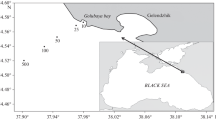Summary
Usually, the oxygen conditions in the lower water layer of a shelf sea area are characterized by the oxygen concentration immediately above the bottom, because this concentration is essential for the bottom living organisms, and as there may be a high oxygen demand due to benthic respiration
For other environmental aspects, however, the vertical distribution in the whole water column must be taken into account. So, a new oxygen deficiency index is proposed. It is difined by the oxygen deficit in the layer between the bottom and the depth witl: 100% oxygen saturation,
Both indexes complement each other. They can be used for
-
a)
Characterizing the actual oxygen situation,
-
b)
recongnizing temporal changes and trends,
-
c)
comparing the oxygen conditions in different areas. For comparison of stations with different depths, the oxygen dificiency index is related to (=divided by) the water depth.
Some examples are given for temporal variations and trends and for spatial differences of the oxygen situation in the south-western Baltic Sea.
Zusammenfassung
Die Sauerstoff-Bedingungen in der unteren Wasserschicht eines Schelfmeeres werden im allgemeinen durch die O2-Konzentration dicht über dem Meeresboden charakterisiert, weil diese für die Boden-Organismen besonders wichtig ist und am Boden häufig O2-Mangel herrscht.
Für andere Umwelt-Aspekte muß man die gesamte Wassersäule in die Betrachtung einbeziehen. Daher wird ein neuer Sauerstoffmangel-Index vorgeschlagen. Er ist definiert durch das Sauerstoff-Defizit in der Schicht zwischen dem Meersboden und der Tiefe mit 100% O2-Sättigung.
Beide Indexe ergänzen einander. Sie können angewendet werden
-
a)
zur Beurteilung der aktuellen Sauerstoff-Situation
-
b)
zur Erkennung von zeitlichen Veränderungen und Trends
-
c)
zum Vergleich der der Sauerstoff-Bedingungen in verschiedenen Gebieten. Zum Vergleich von Stationen mit unterschiedlichen Wassertiefen wird der Sauerstoffmangel-Index auf die Wassertiefe bezogen.
Die Indexe werden anhand von praktischen Beispielen aus der südwestlichen Ostsee erläutert.
Similar content being viewed by others
References
Fonselius, S. H., 1983: Determination of hydrogen sulphide. In: Methods of Seawater Analyses, ed. by K. Grasshof, M. Erhardt, K. Kremling. Weinheim: Verlag Chemie, 73–80
Kalle, K., 1939: Emige Verbesserungen zur Bestimmung des gelösten Sauerstoffs im Meerwasser. Ann. Hydrogr. marit. Met.67, 267–269.
Weichart, G., 1992: Oxygen in the Western Baltic Sea, a Trend Analysis. ICES C. M. 1992, E:17.
Author information
Authors and Affiliations
Rights and permissions
About this article
Cite this article
Weichart, G., Heise, G. & Becker, G.A. A new concept for the assessment of the oxygen situation in a shelf sea area. Deutsche Hydrographische Zeitschrift 46, 263–275 (1994). https://doi.org/10.1007/BF02226954
Received:
Accepted:
Published:
Issue Date:
DOI: https://doi.org/10.1007/BF02226954




